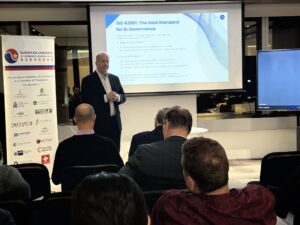As artificial intelligence becomes more embedded in business operations—from hiring and lending to healthcare and law enforcement—so does the responsibility to ensure that these systems behave fairly, transparently, and ethically. One of the biggest challenges in achieving this is algorithmic bias.
Bias in AI systems isn’t just a technical flaw—it’s a governance failure. It can lead to unequal treatment, regulatory scrutiny, reputational damage, and legal risk. In this article, we examine what causes algorithmic bias, why it’s a governance issue, and how businesses can build fairer, more accountable AI with the right frameworks in place—especially with tools like ComplyNexus.
What Is Algorithmic Bias?
Algorithmic bias occurs when an AI system produces outputs that are systemically prejudiced due to flawed data, model design, or deployment context. These biases can be subtle or stark, and they can scale quickly, affecting millions of users or decisions.
Common Examples:
- Recruitment AI screens out candidates based on gender-coded language.
- Credit-scoring models disproportionately lowering scores for certain ethnic groups.
- Facial recognition is underperforming for people with darker skin tones.
These aren’t isolated errors, they reflect broader issues in how AI systems are trained, validated, and governed.
The Root Causes of Bias
Algorithmic bias doesn’t emerge from malicious intent alone. It often stems from:
- Historical Data Bias
Training datasets reflect existing social inequalities. If a dataset contains biased outcomes, the model learns and reinforces those patterns. - Labeling Inconsistencies
Subjective labeling during supervised learning can introduce human bias into the model pipeline. - Limited Representation
Datasets lacking demographic diversity can lead to underperformance for underrepresented groups. - Proxy Variables
Even if sensitive attributes like race or gender are removed, proxy variables (e.g., ZIP code, school history) can still encode bias.
Fact: A 2023 report by the Alan Turing Institute found that 78% of AI systems studied had measurable bias against at least one demographic group.
Why AI Governance Is the Solution
AI governance isn’t just about ticking regulatory boxes—it’s about establishing internal controls and accountability to ensure that AI systems perform ethically and fairly.
Key Governance Principles:
- Transparency: Clear documentation of model design, data lineage, and decision logic.
- Fairness Audits: Regular testing for disparate impacts across demographics.
- Explainability: Ability to explain how an AI system arrived at a decision.
- Stakeholder Inclusion: Involving affected groups in system design and testing.
GL20, ISO 42001, GDPR, and other global frameworks now call for AI systems to be governed with fairness and non-discrimination at the core.
What’s at Stake: Legal, Social & Financial Risks
- Regulatory Action: Non-compliance with fairness standards under GL20 or GDPR can lead to audits, fines, or business restrictions.
- Reputational Harm: Public backlash following biased outcomes can erode brand trust.
- Operational Disruption: Biased AI can cause workflow bottlenecks, customer complaints, and legal exposure.
Statistic: A 2024 Gartner survey predicted that by 2026, 60% of large organizations will have dedicated AI ethics and governance roles to avoid reputational risks.
Building Your Internal AI Fairness Playbook
Ensuring fairness in AI requires more than periodic audits or regulatory compliance—it demands a clear, shared operational strategy. Developing an internal AI Fairness Playbook equips teams with repeatable, scalable practices that embed fairness into every stage of the model lifecycle.
What to Include in Your Playbook:
- Fairness Definition Aligned to Business Context
Define what “fairness” means in your use case (e.g., equal opportunity, demographic parity, equalized odds) and document trade-offs clearly. - Bias Risk Assessment Protocol
Standardise how your team assesses fairness risk—by project, dataset, or model type—before development begins. - Bias Testing Templates
Use structured test cases (e.g., A/B group comparison, disparate impact ratio) across various stages: training, validation, and post-deployment. - Escalation and Accountability Framework
Define thresholds for unacceptable bias and create clear roles for review, mitigation, and sign-off. - Stakeholder Feedback Loops
Collect input from affected users, internal teams, and domain experts to continuously refine the fairness approach.
Insight: Organisations with documented AI fairness protocols are 3x more likely to detect and correct model bias before deployment (Source: McKinsey Global AI Survey, 2023).
By treating fairness as a design principle rather than a one-time audit requirement, you turn risk into resilience, and ethical responsibility into a competitive advantage.
How ComplyNexus Helps Ensure Fairness in AI
ComplyNexus is designed to help businesses stay ahead of bias risks through a robust, actionable AI governance layer. Here’s how:
- Bias Detection Tools: Assess models for fairness across sensitive variables in training, validation, and production stages.
- Audit Trail & Documentation: Automatically track decisions, training datasets, and changes for regulatory reporting.
- Framework Alignment: Stay aligned with GL20, ISO 42001, NIST AI RMF, and other global governance standards.
- Team Training & Role Management: Equip cross-functional teams with tools and protocols to assess and mitigate bias.
By integrating governance into the full lifecycle of your AI models, ComplyNexus ensures that fairness is not just a principle—it’s a process.
Going Forward
Algorithmic fairness must be embedded early and revisited often. The most resilient organisations are those that design governance into the fabric of their AI development workflows. With increasing regulation and rising public expectations, businesses that prioritise fairness today will be the ones trusted tomorrow.
Ready to future-proof your AI systems?
Explore how ComplyNexus can help you govern your AI with fairness, compliance, and confidence.
Request a personalised demo today.
 Skip to content
Skip to content




